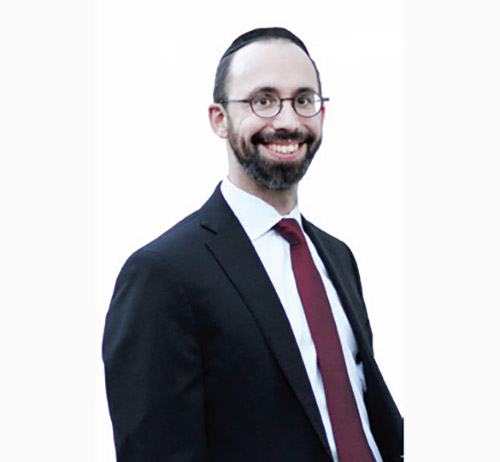
In May of 2017, President Trump visited Eretz Yisrael for thirty-six hours. Over 10,000 policemen were assigned to protect him in Yerushalayim alone. The U.S. shipped to Israel a nine-hundred vehicle convoy. For months in advance, the precise lineup of who would greet the president was arranged. Each person was given an exact time and duration. The people were screened weeks before and the five seconds they would have with the president were well rehearsed.
When President Trump walked off the plane, the lineup of people to shake his hand was primed and ready. Oren Hazan, an Israeli official, was not scheduled to shake the President’s hand, but somehow jumped in front of the President, shook his hand and then pulled out his phone to take a selfie with the president. Amazing!
The time period between Rosh Hashanah and Yom Kippur is called the ten days of repentance. The Gemara tells us that during these ten days, Hashem is incredibly close to us—more than any other time of the year. And this Shabbos, which falls within this precious island in time, is called Shabbos Shuva, a particularly appropriate day to focus on teshuva.
This designation of the ten days of repentance has made me curious for a long time. During the Musaf prayer of Rosh Hashanah, we articulate that on Rosh Hashanah the verdict is written and on Yom Kippur it is sealed. So, when are things really decided? The answer is inferred from the Vilna Gaon who says there are 365 days in the solar calendar and 355 days in the lunar calendar. The difference between the two is ten days. The nations of the world are compared to the sun and the Jews to the moon and we each cling to our own calendar. The ten days of repentance are, in effect, out of this world. The Jewish people are in a different plane and time zone. What occurs to them is decided in a different realm. Rav Shimshon Pincus says that by our focusing on teshuva during these ten days, we bring extra light to the world and gain a tremendous sense of clarity.
Rosh Hashanah itself is exceedingly special in Jewish history. We have witnessed nature bending its rules on this day. On Rosh Hashanah, we read how three barren women—Sarah, Rachel and Channah—were healed by Hashem and they became pregnant. Our people’s status changed instantly when slavery in Mitzrayim ended on Rosh Hashanah. Our esteemed Yosef Hatzadik was freed from prison on Rosh Hashanah.
A huge challenge with Rosh Hashanah and Yom Kippur is that many of us get overwhelmed. There is SO much at stake. Can we really pull it off—doing teshuva?? I have some good news for you.
The Chida tells us where to start and how easy and simple it is. First, let’s look at teshuva. The Rambam says it has four steps: stopping the sin, having remorse for the past sin, confession and an acceptance to never do it again. Okay, this sounds really daunting! But wait…the Chida tells us that during these ten days, there is a different path to return to Hashem. Any little movement we take towards Hashem is considered teshuvah!
How is that possible? What happened to the Rambam’s four steps?? It seems the Chida is telling us that during this very special time, Hashem is so close, we can “pull a selfie.” We can jump forward and directly connect with the Almighty, avoiding the normal protocols. Just a determined step is needed, however small.
In the 1950’s, Rabbi Emanuel Feldman became the rabbi of Congregation Beth Jacob in Atlanta, Georgia. There were just a handful of shomer Shabbos Jews at that time in Atlanta. Now, it’s a vibrant Torah community. How did Rabbi Feldman build such a wonderful community? On his first Yom Kippur there, Rabbi Feldman asked everyone to accept upon themselves just one mitzvah…for one year. The following year, he asked again. Just one more mitzvah and for just one year. Year after year, the community grew slowly and steadily, both spiritually and in numbers. When he retired 50 years later, a vibrant community surrounded Rabbi Feldman. With only one little step at a time. This transformation was illustrated by the sapling Rabbi Feldman planted in the front yard of the shul when he first became the Rabbi. When he retired, the sapling had become a huge tree!
Let’s make that one commitment. It’s Hashem’s gift to us this time of year—a little step towards Him is all it takes. We can plant a little tree and watch it grow and blossom by taking that first step. Let’s do it together.
By Rabbi Baruch Bodenheim
Rabbi Baruch Bodenheim is the associate rosh yeshiva of Passaic Torah Institute (PTI)/Yeshiva Ner Boruch. PTI has attracted people from all over northern New Jersey, including Teaneck, Bergenfield, Paramus, Rockaway and Fair Lawn. He initiated and continues to lead a multi-level Gemara learning program. Recently he has spread out beyond PTI to begin a weekly beis midrash program with in-depth chavrusa learning in Livingston and Springfield. This year he joined Heichal Hatorah in Teaneck as a Gemara iyun rebbe. His email is [email protected].










